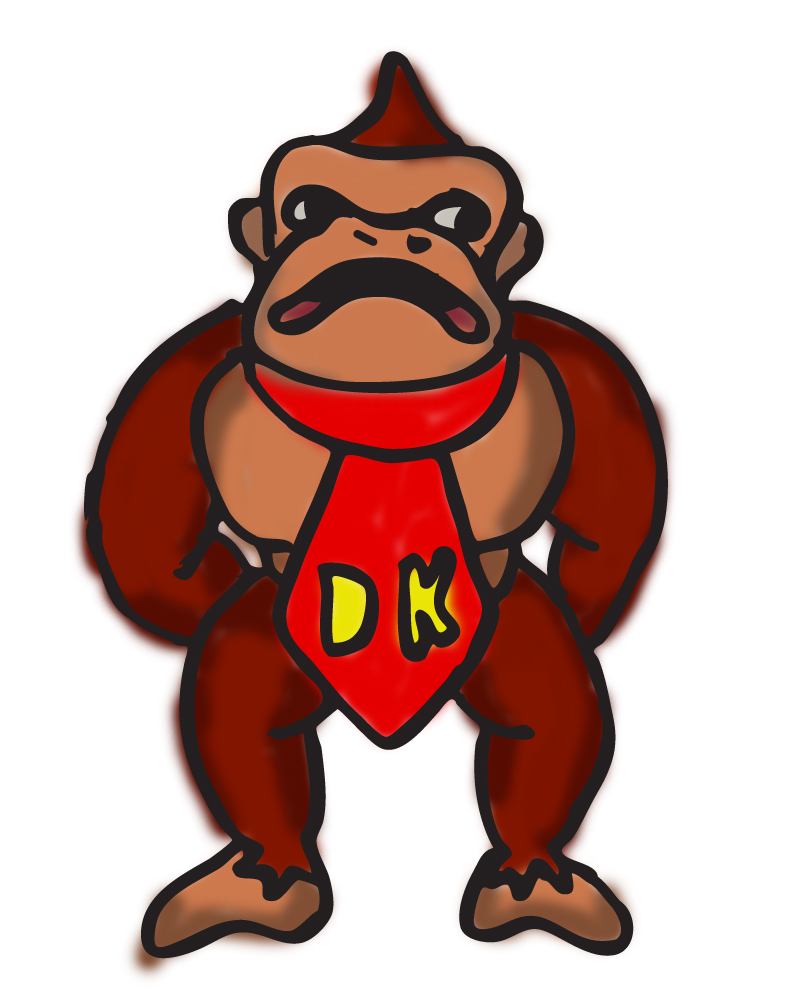
I. Development
In the early 1990s, Nintendo was facing stiff competition in the North American home console market from competitor Sega’s Genesis. Nintendo’s 16-bit console, the Super Nintendo, which succeeded the original, hyper-successful Nintendo Entertainment System and launched in 1991 in North America, was undeniably powerful at the time, but Nintendo had maintained what many viewed to be an antiquated aesthetic. Games like Super Mario World and The Legend of Zelda: A Link to the Past were unabashedly colorful and cute and quintessentially Japanese. Through an ingenious ad campaign, Sega distinguished themselves as the game developer for rollerbladers, Luke Perry, and other assorted 90s badasses. If Nintendo were the Beatles, then Sega were the Rolling Stones. Mario? That was Kid Shit, and Nintendo—perpetually insulated from trends, its developers siloed off in Neverland—couldn’t fire back.
They turned to a small game developer called Rare—then, Rareware—located in the similarly small English village of Twycross. The company’s founders—brothers Tim and Chris Stamper—had discovered a way to compress scrupulously rendered 3D models and backgrounds onto a Super Nintendo cartridge. Their pitch was given the green light by Nintendo, and Rare were licensed a Nintendo property—in this case, Donkey Kong—for a game that would serve as the guinea pig for this new technology.
The result was Donkey Kong Country. At 9 million units sold, Donkey Kong Country is the second best-selling Super Nintendo game of all time. With Donkey Kong Country, Rare disinterred Donkey Kong—who was at that point remembered mostly for being Mario’s first antagonist in the titular arcade game from 1981—and catapulted his dusty corpse towards the vanguard of leading video game mascots. DKC proved the Super Nintendo’s technological and cultural superiority over the Sega Genesis. Its release date was surely the first of many dark days for Sega.
Nintendo would go on to acquire 49% of Rare. During the Nintendo 64 era, the developer proved to be an invaluable asset to Nintendo. Five of the top 20 best-selling Nintendo 64 games are Rare titles; Donkey Kong 64 sits snugly at 7th place, having sold a whopping 5.2 million units. Rare was one of the preeminent game developers of the late 90s, if not the preeminent Western game developer of the late 90s.
Donkey Kong 64 was Nintendo’s marquee title during the 1999 holiday season, and a massively ubiquitous ad campaign surrounded the game. For a brief moment, Donkey Kong 64 commanded the playground; it was on everything from Lunchables to cans of Dr. Pepper. It promised to be bigger, better, and more badass than any 3D platformer that preceded it. (Case in point: Donkey Kong could use a gun.)
Donkey Kong 64 was developed amidst an atmosphere of unbridled enthusiasm and creative ambition at Rare. “It was quite the heyday for [us],” says Mark Stevenson, who served as the game’s lead artist, and is currently employed at Playtonic Games—a small developer and haven for former Rare employees whose breakout Yooka-Laylee series is a love letter to 90s platformers. “We were coming off the success of Donkey Kong Country, and we had Goldeneye 007 and Banjo-Kazooie. Without wanting to sound arrogant, it kind of seemed like our greatest competition was ourselves.”
Stevenson says that Rare was notorious for isolating its different development teams from each other, much like Nintendo did with its distinct R&D units. “There were different security doors [leading into each office bloc] that would only work with your key,” he says. “They liked to keep us separate and I think they wanted to create that competition between us.”
The game was also a response to immense pressure from Nintendo, who needed a blockbuster title to package with their new “Expansion Pak”—a RAM expansion cartridge of nebulous technological import that popped into the front of the Nintendo 64 console.
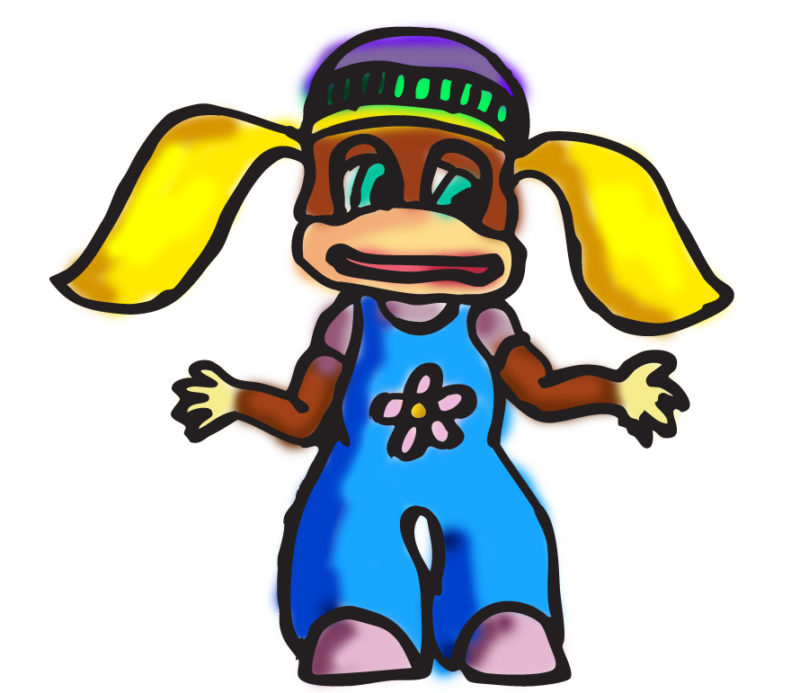
“[Donkey Kong 64] was massively important to Nintendo at the time,” Stevenson says. “They wanted us to use the Expansion Pak they had, which ended up being bundled with the game, and it was always difficult to sell new hardware without fracturing your base. I think Donkey Kong 64 could just be considered the trojan horse that got that thing into as many consoles as possible.”
Stevenson tells me that Donkey Kong 64 began development immediately after Donkey Kong Country 3’s release in 1996, though switched gears at least once before the developer landed on the build and premise that constitutes the final game: “Originally, it was more of ‘2.5’ platformer, kind of like Crash Bandicoot. But I think people at the company weren’t happy with how it was going, and it became apparent that making levels [in that style] would be a massive task.”
“[Rare decided that] the logical thing to do was to go down the Banjo or Mario 64 path, of having different 3D worlds which you could constantly re-explore. The version of Donkey Kong 64 we ended up releasing was 18 months of development from start to finish. It was a serious amount of time and work, and everyone was working ridiculous hours on it.”
In order to assist with the game’s transition into a fully 3D platformer, Rare tasked Banjo-Kazooie’s assistant designer George Andreas with directing the game. Banjo-Kazooie‘s composer Grant Kirkhope also got the call.
“I was already doing Banjo-Tooie and Perfect Dark at the time, so with DK64 I was like, ‘Oh, it’s going be a lot of work to do three games at once.’ But I wanted to do it and George and I are friends. Donkey Kong was pretty special to Rare and me.”
Despite its arduous development cycle, Donkey Kong 64’s development itself doesn’t seem like it was too eventful. When I ask Stevenson and Kirkhope to recall notable aspects of the game’s creation, I can practically hear both of them scratching their heads.
Input from the higher-ups at Nintendo was negligible, according to Stevenson. Not even Shigeru Miyamoto—Mario and Donkey Kong’s creator—had much to say. “I don’t know how much contact he had [with Tim and Chris Stamper] at the time, but I kind of got the impression that he would have preferred we make a 2D-style game, instead of another 3D Mario or Banjo-Kazooie-type game,” he says. “They just left us to get on with it. They trusted us quite a lot.”
In 2002—three years after Donkey Kong 64’s release—Rare were purchased by competitor Microsoft for $375 million. Rare—now a Microsoft subsidiary—retains the rights to Perfect Dark, Banjo-Kazooie, and its other intellectual properties. The license on Donkey Kong—and every character Rare created for the franchise during its run with it—was reverted back to Nintendo.
Consequently, Donkey Kong 64 is a black sheep in both Rare and Nintendo’s catalogs. Aspects of the game are seldom referenced in newer Donkey Kong games, and Nintendo hasn’t even experimented with a mainline, 3D Donkey Kong game since.
By virtue of the Microsoft sale, Rare aren’t really at liberty to discuss their Donkey Kong games on-the-record, either. The 2015 Xbox One anthology Rare Replay contained thirty emulated Rare games—including many of their N64 classics—in addition to complimentary behind-the-scenes content and documentaries on each game’s development. Donkey Kong 64 was an obvious, though no less glaring, omission.
These days, Donkey Kong 64 is almost completely absent from the industry’s consciousness. Last year, the Ringer published an article on Banjo-Kazooie to coincide with that game’s 20-year anniversary entitled “How ‘Banjo-Kazooie’ Became a Bridge Between Marios.” The piece’s thesis is that Banjo-Kazooie—although criticized by some for being a Super Mario 64 clone—foreshadowed aspects of future 3D Mario platformers such as 2017’s Super Mario Odyssey. For some reason, a similar redemption narrative constructed around Donkey Kong 64—despite being the better-looking, better-selling, better-sounding, and more experimental product—would seem comparatively ridiculous.
With regards to Donkey Kong 64’s development, there may simply be less to chronicle. Stevenson, especially, doesn’t seem particularly passionate talking about the game: It was just a game. Nintendo ordered it and Rare made it.
But Kirkhope seems to think that optics might play a part in the game’s current status as a (best-selling) lost gem. “I do feel like it gets overlooked,” he says. “If it had been rereleased like Banjo’s been on different platforms umpteen times, we might feel like it’s stood the test of time better. If it was ported to the Switch, maybe that would make a difference. But it’s Nintendo’s game completely now. That’s probably why [nobody talks about it] too much.”
II. The Problem
I will never forget the first time I played Super Mario 64.
My semi-estranged paternal grandfather sent me a Nintendo 64 for my birthday on Christmas Eve, 1997. The package included two games—Star Wars: Shadows of the Empire, which my parents quickly deemed too violent for a six-year-old, and Super Mario 64.
Before this, my experience with video games was largely passive. I remember watching friends play Mortal Kombat on a Super Nintendo, and I ate a lot of Sonic the Hedgehog Spaghettios.
Super Mario 64 was the first time a video game sucked me in. It gave me something to discuss with other kindergarteners, temporarily supplanting my obsession with The Beatles and other 60s and 70s pop culture ephemera nobody in my peer group cared about. I liked video games now. I belonged to the zeitgeist.
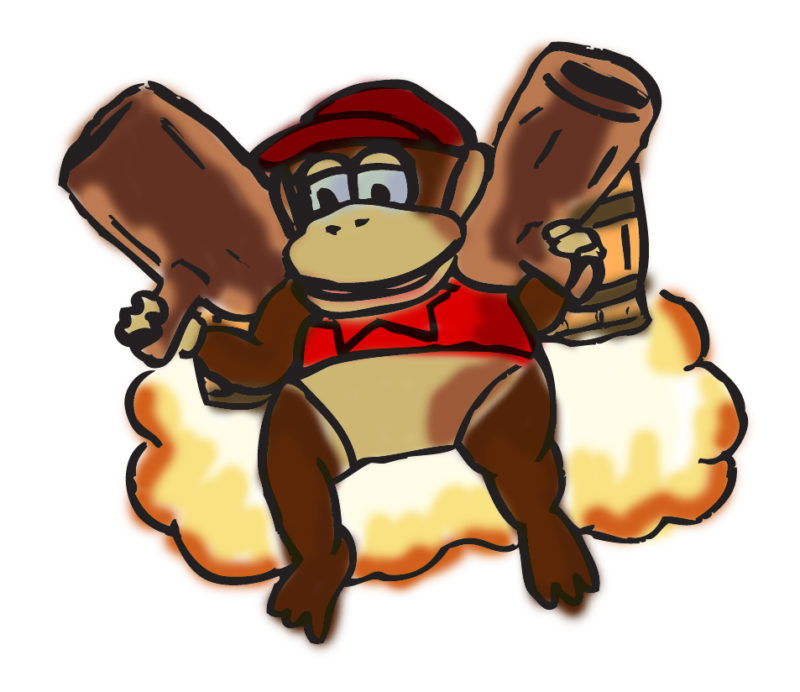
I got a little older, and more sullen. By the time I was seven, I was a nervous wreck; I forced myself to stay awake all night out of fear that my parents would leave, and developed an unhealthy preoccupation with death and ontology. My fate as a future philosophy major—and eventual philosophy major dropout—was sealed.
Video games were a respite from the unrelenting terrors of my conscious mind. When I beat Super Mario 64, I cried. Not out of relief or a sense of nostalgia, but because the game had run its course. I no longer had anything to do.
Counterproductively, my parents decided video games were part of the problem. I wasn’t allowed to play them anymore. They bought into the neo-hippie agitprop that video games rot your brain. So they put me on an antidepressant instead.
I was still allowed to play video games when I visited my aunt’s, which was usually twice a year—once in the summer, and once in the winter. She lived in San Francisco, which was considerably less miserable than my hometown of Portland during the chilly months.
There was no limit on “screen time” there. Additionally, I could eat and drink as much garbage as I wanted. When I visited in the beginning of 2000, Donkey Kong 64 had been out for two months; I begged my aunt to rent it for me, and she did. I played the game through the night, shotgunning Diet Pepsis and sustaining myself on Red Vines plucked from a potluck-sized plastic tub. I didn’t finish it completely, but I got as close as any child—even one with an obsessive-compulsive tenacity—could in a week and a half. It was the biggest game I had ever played, and playing it was like a religious awakening.
This past August, I experienced possibly the most virulent panic attack of my entire life. I disassociated and collapsed on the floor of a Starbucks. I quit my job that night. “Take some time to yourself,” my therapist said during our next appointment. “Just find something to do for awhile that’s grounding.”
I started playing Donkey Kong 64 for the first time in years. This time, I was going to collect everything.
III. Objects
I have been playing Donkey Kong 64 for a few months now, and I am about two-thirds of the way through the game; I have not collected everything. I have also not been able to play it consistently, as I am no longer a child.
Somehow, Donkey Kong 64 still feels like one of the biggest games I’ve ever played. Earlier entires in the Donkey Kong series—specifically the stellar Donkey Kong Country trilogy for the Super Nintendo—were quintessential 2D platformers. You merely had to get from Point A to Point B of every level without running into any obstacle or enemy that could kill you. Like in the Mario or Sonic the Hedgehog games, the collectibles in the Donkey Kong Country series were largely level exclusive power-ups that served a practical purpose—if you collected 100 bananas, you acquired a 1-up, and so on. Donkey Kong Country 2 and 3 introduced a wider variety of collectibles—such as the Banana Coins, the massive gold “Kremkoins” and DK Coins, which all look confusingly similar—that served inter-level purposes. These items were by no means requisite for completing the game, and permitted the player to participate in certain bonus stages or access the games’ “real” ending.
By comparison, the whole point of Donkey Kong 64 is to collect different objects, most of which look confusingly similar. There’s a catch here, too—there are five, unique playable characters—Donkey Kong, Diddy Kong, Tiny King, Lanky Kong, and Chunky Kong—each with a corresponding color. Although there are a few items in Donkey Kong 64 that are accessible to every character, many of the most essential ones are gated off to that specific character’s color and/or unique abilities. And you can’t cycle between playable characters automatically—in order to switch Kongs, you have to return to “Tag Barrels” which are placed throughout each level. (But they never seem to be around when you need them most.) At the risk of reading like a GameFaqs walkthrough, here is a list of every major collectible in Donkey Kong 64, along with a brief description of what exactly (I think) it is that they do:
- Golden Bananas: The equivalent of Banjo-Kazooie’s “Jiggies” or Power Stars from Super Mario 64. These open new worlds.
- Bananas (color-coordinated): To pass the gate that leads to each world’s boss requires the acquisition of a set number of these.
- Banana Balloons (color-coordinated): Contains multiple bananas of that Kong’s color variant.
- Banana Coins (color-coordinated): In-game currency. Can be traded for new abilities, Kong-specific firearms, Kong-specific musical instruments, an expanded health gauge, etc.
- Watermelon Slices: Refills the player’s health gauge.
- Oranges: Can be used as grenade-like weapons by every member of the Kong family.
- Crystal Coconuts: Allows the player to perform special abilities; this item takes its name from the abysmal straight-to-VHS Donkey Kong Country TV show anthology, Legend of the Crystal Coconut.
- Ammo Crates: Restocks the player’s ammunition once they receive a firearm from Funky Kong—the Kong family’s “cool uncle.”
- Banana Medals: Serve no functional purpose whatsoever, although 15 of them are required to obtain the Rareware Coin. (Which is, itself, required for completing the game—see below.)
- Blueprints (color-coordinated): Kongs can exchange these 1:1 for a Golden Banana. (See above.)
- Battle Arena Crowns: Awarded for completing “death match” bonus stages located in each world. A set number of these are required for completing the game.
- Boss Keys: Awarded after beating a world boss. Necessary for completing the game.
- Banana Camera film: Allows the player to take photos of “Banana Fairies”—after a photograph is successfully taken, the Banana Fairy will replenish the character’s core stats.
This might not seem especially daunting, but when you consider that Donkey Kong 64 is practically littered with these objects—and when you take into account the color-coordination and cross-functionality of many of these items—you begin to get the picture. If my math is right, there are a total of thirty-three unique item categories present in Donkey Kong 64.
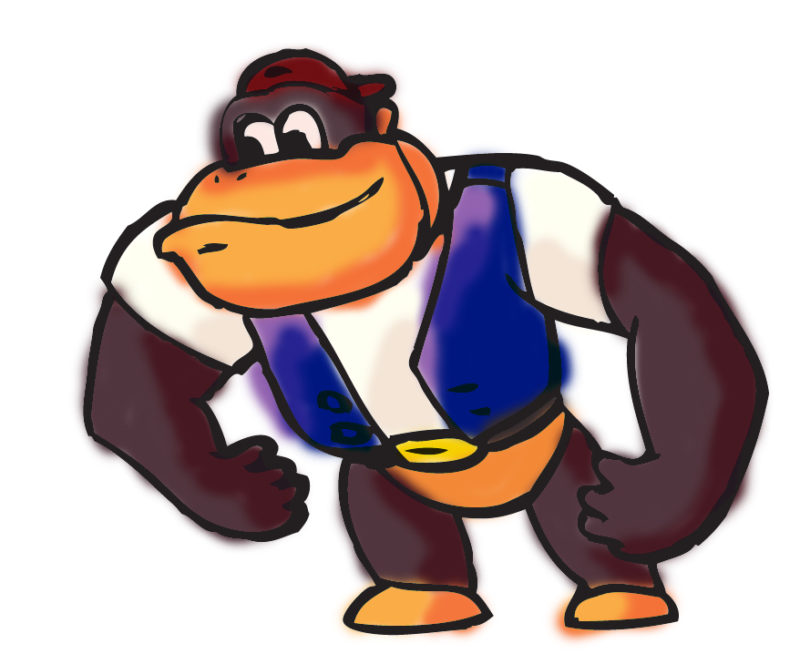
This has led Donkey Kong 64 to be referred to as a “collect-a-thon.” It is one of the most divisive games in the Nintendo canon, and retrospectives on it are generally less charitable than this one. The game’s detractors view it as the worst “classic” 3D platformer, and an anticlimactic conclusion to developer Rare’s otherwise spotless tenure with the franchise—a bloated, superficial sandbox game bereft of spirit. Its fans, on the other hand, remember it as an immersive, maximalist console classic, filled with colorful characters, memorable environments, and a terrific soundtrack.
Both perspectives are valid. As I’m replaying Donkey Kong 64 twenty years after the game’s initial release date, I can’t help but feel frustrated by its more outmoded mechanics. But I’m also consistently amazed that developer Rare found a way to cram a game this big and cinematic onto a relatively minuscule Nintendo 64 cartridge. Along with The Legend of Zelda: Majora’s Mask, Donkey Kong 64 is arguably the most technologically impressive game on the Nintendo 64. Unlike the first two Banjo-Kazooie games—which seldom stray from a fantastical, Merrie Melodies-esque setting—DK64 is constantly oscillating between contrasting aesthetic timbres. Genuinely creepy moments are offset by glimmers of levity—like Tiny Kong playing her saxophone, or Chunky Kong making pained, juvenile grunting noises whenever he does anything—and vice versa.
This is apparent as soon as the game starts, when the player is spat out onto Donkey Kong Island, the game’s world hub. It is a benevolent, tropical paradise, a fact underscored by composer Grant Kirkhope’s sweeping, definitively major-key theme. But as you swim off the shore towards the neighboring, mechanical Crocodile Isle—which is actually a giant naval fortress under the dominion of the series’ “big bad” King K. Rool and his army of Kremlings—the sky turns overcast and you hear the crackle of thunder; rain begins to fall, and the score abruptly contorts into its parallel minor counterpart.
Kirkhope admits this is a gimmick he lifted from Lucas Arts and their Monkey Island series of games for the PC. “You would hear different versions of the tune wherever you went on the island, and I thought that was amazing,” he says. Something similar was also employed by composer Koji Kondo with 1990’s Super Mario World on the Super Nintendo—a game whose music retained the same melodic structure and motifs throughout, but changed slightly in instrumentation or modality to match the “feeling” of each level. But Donkey Kong 64—with its evocative, diverse environments and seamless transitions between those environments—did it better than Super Mario World or the Monkey Island games. Kirkhope’s score isn’t just an essential video game soundtrack in its own right—it demonstrates the purpose of music in a video game, and speaks to the symbiotic relationship between music and visual media as a whole.
“I always thought that with video games, there was no reason we couldn’t write real music,” Kirkhope tells me. “I think people used to think video game music had to sound like a video game—but you can take those pieces and orchestrate them now and they’d sound as modern as anything. I do feel like Rare took the time to make ‘proper’ music [for their games.]”
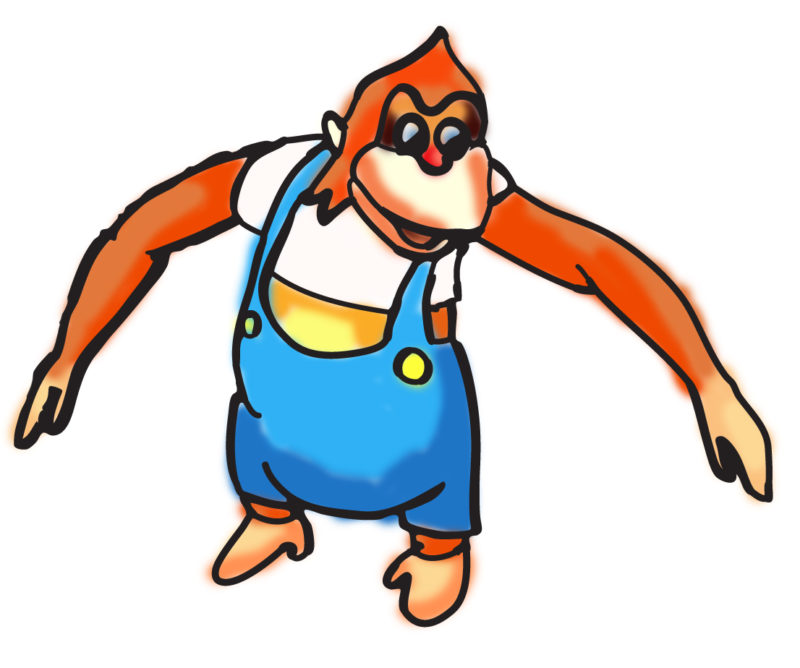
Donkey Kong 64 represents both the nadir and apex of 3D platformers. It is the Abbey Road of its medium—a superficially flawless mess.
Donkey Kong 64 is also weirdly prophetic. In video games, there used to be a pretty significant rift between immersive escapism—a category occupied by first-person shooters, action games, and Japanese role-playing games—and true-blue simulators like flight games, the Sim franchise, or bad sports games. If you were a kid in the 90s or early 00s who played video games, you steered clear of any “game” that felt insidiously didactic. The less it reminded you of the real world the better.
That gulf is closing rapidly, however. A newer, AAA-title like Red Dead Redemption 2 is the subject of breathless praise from gamers and critics alike precisely due to its marriage of immersive escapism with mind-numbing realism. This is a characteristic wholly unique to the medium; “It’s so amazing you’ll forget you’re playing a video game” is a compliment now, although I’m not sure that’s good news for those who like fun games and dislike reality.
It is spurious to suggest that Donkey Kong 64 is any kind of real antecedent to Red Dead Redemption 2 or bellwether of modern game design philosophy; it is a drop in the bucket, a product confined to its time, and it might not even deserve this degree of memorialization. DK64 was, however, the first time I felt personally manipulated by a video game into doing something I could just as easily be doing in real life: collecting and indexing random garbage.[1]
IV. Control
There is a scene in the beginning of the 1991 comedy What About Bob? when Bill Murray’s character, Bob Wiley, fakes a Tourette’s outburst and then a heart attack during his intake with psychiatrist Dr. Leo Marvin (Richard Dreyfuss).
“Why, exactly, are you doing this?” Dr. Marvin asks.
“If I fake it, then I don’t have it,” Wiley responds.
I think about this scene almost daily. Video games are simulacra of control, and control is what every neurotic craves; they give us permission to do things in a world which otherwise grants us very little agency. Control is endlessly meaningful for those who feel like they have none.
Some say video games may be rotting my brain. Whether or not that’s true, I know they’ve altered my consciousness for the better.
“You’re the first person I’ve spoken to who hasn’t mentioned the ‘DK Rap,’” Kirkhope says at the end of our interview, chuckling. Kirkhope is of course referring to Donkey Kong’s 64’s infamous opening scene: An overview of each character’s attributes disguised as a laughably pathetic approximation of a hip-hop song. It is as bad as it sounds, and possibly worse than you remember.
“I just spoke with these parents whose kid was having difficulty speaking,” Kirkhope says. “They said, ‘she actually just started speaking after learning the ‘DK Rap.’ That kind of thing is just so amazing and makes it all so worthwhile. Video games really can change peoples’ lives, and the fact that they have a daughter who was having a difficult time speaking but can now recite the ‘DK Rap…’ That’s leaps and bounds.”
[1] Donkey Kong’s haul, officially, is referred to as his “Banana Hoard.”




